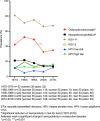Seroprevalence of sexually transmitted infections over 44 years - A cross-sectional study in Sweden
- PMID: 38659325
- PMCID: PMC11308287
- DOI: 10.1177/09564624241248874
Seroprevalence of sexually transmitted infections over 44 years - A cross-sectional study in Sweden
Abstract
Background: Sexually transmitted infections (STIs) may cause substantial individual suffering and a large economic burden for society. This study examined the seroprevalence of Chlamydia trachomatis, Mycoplasma genitalium, herpes simplex virus (HSV) types 1 and 2, and several human papillomaviruses (HPV) in the Swedish population over time.
Methods: The study population consisted of 30-year-old women attending maternity care, and 50 year-old men and women attending health check-ups, from 1975 to 2018. Antibody status was determined by multiplex serology and quantified using median reporter fluorescence intensity (MFI).
Results: A total of 891 samples were analysed (519 from 30-year-old women, 186 from 50 year-old women and 186 from 50 year-old men). Of these, 41.5% showed seropositivity for Chlamydia trachomatis, 16.7% for Mycoplasma genitalium, 70.5% for HSV-1, 14.9% for HSV-2, 13.2% for high-risk HPV, and 8.3% for low-risk HPV. Seropositivity for Mycoplasma genitalium, HSV-1 and especially Chlamydia trachomatis decreased over time.
Conclusions: There was a decrease over time in Chlamydia trachomatis seroprevalence, probably due to contact tracing, testing and early treatment; this might also have affected Mycoplasma genitalium seroprevalence. Despite the reduction, seroprevalences are still high, so continued and new efforts to reduce STI incidence are essential.
Keywords: Chlamydia (Chlamydia trachomatis); HPV (Human papillomavirus); HSV (Herpes simplex virus); bacterial disease; viral disease.
Conflict of interest statement
Declaration of conflicting interestsThe author(s) declared no potential conflicts of interest with respect to the research, authorship, and/or publication of this article.
Figures



Similar articles
-
Seroprevalences of herpes simplex virus type 2, five oncogenic human papillomaviruses, and Chlamydia trachomatis in Katowice, Poland.Clin Vaccine Immunol. 2008 Apr;15(4):675-80. doi: 10.1128/CVI.00260-07. Epub 2008 Feb 20. Clin Vaccine Immunol. 2008. PMID: 18287578 Free PMC article.
-
Clustering of seropositivities for sexually transmitted infections.Sex Transm Dis. 2002 Apr;29(4):207-11. doi: 10.1097/00007435-200204000-00004. Sex Transm Dis. 2002. PMID: 11912461
-
STI with Mycoplasma genitalium-more common than Chlamydia trachomatis in patients attending youth clinics in Sweden.Eur J Clin Microbiol Infect Dis. 2019 Jan;38(1):81-86. doi: 10.1007/s10096-018-3395-3. Epub 2018 Oct 16. Eur J Clin Microbiol Infect Dis. 2019. PMID: 30327896
-
Diagnosis and Treatment of Sexually Transmitted Infections: A Review.JAMA. 2022 Jan 11;327(2):161-172. doi: 10.1001/jama.2021.23487. JAMA. 2022. PMID: 35015033 Review.
-
The vaginal microbiota and its association with human papillomavirus, Chlamydia trachomatis, Neisseria gonorrhoeae and Mycoplasma genitalium infections: a systematic review and meta-analysis.Clin Microbiol Infect. 2019 Jan;25(1):35-47. doi: 10.1016/j.cmi.2018.04.019. Epub 2018 May 3. Clin Microbiol Infect. 2019. PMID: 29729331 Free PMC article.
Cited by
-
Cytokine secretion patterns distinguish herpes simplex virus type 2 meningitis from herpes simplex virus type 2 genital herpes.Front Immunol. 2025 Jun 4;16:1515741. doi: 10.3389/fimmu.2025.1515741. eCollection 2025. Front Immunol. 2025. PMID: 40534882 Free PMC article.
References
MeSH terms
Substances
LinkOut - more resources
Full Text Sources
Medical

